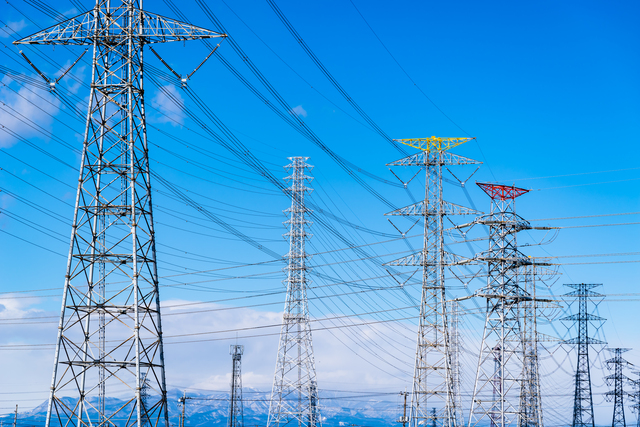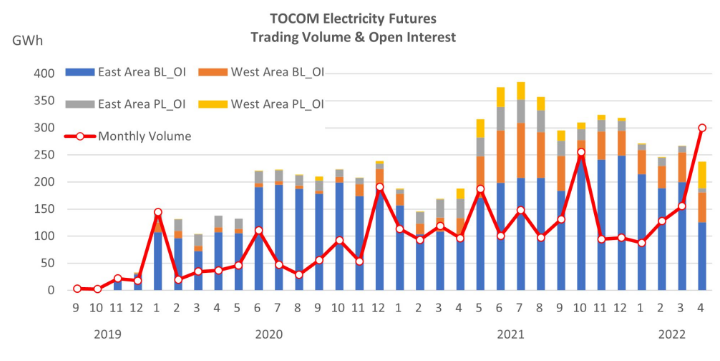TOCOM Energy
Electricity futures trading expands rapidly with Japan’s growth prominent to avoid price volatility

Electricity futures trading is expanding. This is because electricity prices are becoming more volatile worldwide due to rising geopolitical risks and extreme weather conditions, which increase demand for hedging against price volatility. This year’s futures trading volume is on pace to increase 50% from last year in Germany, which has the highest trading volume worldwide. In Japan, where futures trading is still lagging behind other countries, trading volume has surged nearly fourfold.
Electricity futures is derivatives transactions in which electricity is bought and sold at a fixed price in the future, such as one year from now. It settles the difference in value from electricity procured from spot exchanges and other sources. By trading futures contracts in advance of selling or procuring, electricity sellers can fix their selling prices and buyers can avoid unexpected increases in procurement costs.
Electricity futures trading is particularly active in Europe. With the progress of electricity liberalization, risk hedging through the futures market has spread since the 2000s. The most active futures market is Germany, where the trading volume far exceeds that of spot trading.
According to the European Energy Exchange (EEX), Germany’s cumulative trading volume from January to September amounted to approximately 4.15 million GWh (Electricity equivalent; 1 GW is 1 billion watts). The annualized expansion rate has remained strong, increasing 52% from the previous year.
The increase in electricity futures trading is due to the continued unstable environment for electricity prices worldwide. The war in Ukraine and the deteriorating situation in the Middle East have increased volatility in natural gas and other fuel prices. Extreme weather conditions such as heat waves and heavy rains, as well as the spread of weather-sensitive renewable energy sources, such as solar-powered generation, have also increased the swing in electricity supply and demand, making electricity prices rougher.
On the other hand, although Japan’s electricity futures trading volume is still smaller, the expansion rate far exceeds that of Germany. The total trading volume of EEX and Tokyo Commodity Exchange (TOCOM), a group company of JPX, was 50,000 GWh in the January-September period, 3.8 times higher than the same period last year (3.6 times higher on an annualized basis). In September alone, the total volume reached a record high of approximately 7,500 GWh, a seven-fold increase over the same month last year. In terms of market size, the cumulative trading volume for the January-September period exceeded that of Switzerland and Austria.
Until now, some of Japan’s major utility companies and new power providers and suppliers have procured power on the wholesale spot market or through bilateral transactions, and fluctuations in the price of electricity have tended to have a large impact on their earnings. Using futures trading has increased to avoid price volatility risk, which leads to a virtuous cycle of improving liquidity and increasing market participants.
The number of larger-sized market participants is also increasing. According to the EEX, as of September, there were 25 large companies on the exchange that traded a cumulative total of more than 100 GWh per month, 3.6 times more than the same month last year. The number of companies trading more than 500 GWh has also increased from zero in the previous year to nine.
Citadel, a major US hedge fund, has entered the Japanese market through its acquisition of Energy Grid, a start-up Japanese electricity wholesaler. Yohei Kinosaki, president of Energy Grid, says, “By utilizing Citadel’s capital, we have expanded the trading scale and can provide many market participants with the opportunity to manage long-term price fluctuation risks.”
ICE Futures Europe also announced on October 21 that it will enter the Japanese electricity futures market. Transactions will begin on December 9, subject to completion of regulating authority procedures.
On the other hand, TOCOM, where new power providers and suppliers are the main traders, has a smaller trading volume than EEX. However, there have been some recent cases of major financial institutions’ participation, such as MUFG Bank, acquiring trading participant qualification in TOCOM.
Since TOCOM has smaller trading units than the EEX, there is a movement among relatively small businesses, such as new regional power providers, to utilize TOCOM. Ken Kashima, president of Tsuru Energy (Tsuru city, Yamanashi Prefecture), a regional new power provider in Yamanashi Prefecture, says, “To ensure a stable supply of electricity at stable prices to customers in the region, we currently hedge 80% of our procurement during high-demand periods through TOCOM.”
If the electricity futures market can be deepened by a variety of players, hedging transactions can be more easily utilized. In Europe, fixed electricity price menus have become widespread by leveraging futures transactions, and the pricing system is less exposed to fluctuations in fuel, and other factors have spread to the retail level. If hedging transactions are utilized more widely in Japan, it is expected that companies and consumers will be able to enjoy stable electricity prices.
Moves to offer new fee menus utilizing futures are beginning to emerge in Japan. erex, a major new electric power provider, offers fixed pricing plans in summer and winter when electricity prices tend to rise or throughout the year. As of October 1, these plans accounted for about one-third of the high-voltage contracted electricity offered.
Regardless of country or region, the environment is likely to remain volatile for spot electricity prices due to heightened geopolitical risks and extreme weather conditions. It is highly likely that trading volume in the electricity futures market will continue to expand in response to the growing demand for stabilizing electricity prices.
Related links






